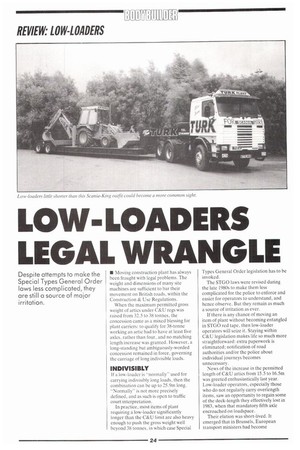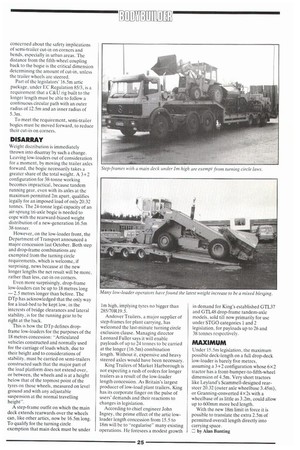LOW-LOADERS GAL WRANGLE
Page 136

Page 137

If you've noticed an error in this article please click here to report it so we can fix it.
Despite attempts to make the Special Types General Order laws less complicated, they are still a source of major irritation.
• Moving construction plant has always been fraught with legal problems. The weight and dimensions of many site machines are sufficient to bar their movement on British roads, within the Construction & Use Regulations.
When the maximum permitted gross weight of artics under C&U regs was raised from 32,5 to 38 tonnes, the concession came as a mixed blessing for plant carriers: to qualify for 38-tonne working an artic had to have at least five axles, rather than four, and no matching length increase was granted. However, a long-standing but ambiguously-worded concession remained in force, governing the carriage of long indivisible loads.
INDIVISIBLY If a low-loader is "normallyused for carrying indivisibly long loads, then the combination can be up to 25.9m long. -Normally" is not more precisely defined, and as such is open to traffic court interpretation.
In practice, most items of plant requiring a low-loader significantly longer than the C&U limit are also heavy enough to push the gross weight well beyond 38 tonnes, in which case Special Types General Order legislation has to be invoked.
The STGO laws were revised during the late 1980s to make them less complicated for the police to enforce and easier for operators to understand, and hence observe. But they remain as much a source of irritation as ever.
If there is any chance of moving an item of plant without becoming entangled in STGO red tape, then low-loader operators will seize it. Staying within C&U legislation makes life so much more straightforward: extra paperwork is eliminated; notification of road authorities and/or the police about individual journeys becomes unnecessary.
News of the increase in the permitted length of C&U artics from 15.5 to 16.5m was greeted enthusiastically last year. Low-loader operators, especially those who do not regularly carry overlength items, saw an opportunity to regain some of the deck-length they effectively lost in 1983, when that mandatory fifth axle encroached on loadspace.
Their elation was short-lived. It emerged that in Brussels. European transport ministers had become concerned about the safety implications of semi-trailer cut-in on corners and bends, especially in urban areas. The distance from the fifth-wheel coupling back to the bogie is the critical dimension determining the amount of cut-in, unless the trailer wheels are steered.
Part of the legislators' 16.5m artic package, under EC Regulation 85/3, is a requirement that a C&U rig built to the longer length must be able to follow a continuous circular path with an outer radius of 12.5m and an inner radius of 5.3m.
To meet the requirement, semi-trailer bogies must be moved forward, to reduce their cut-in on corners.
DISARRAY
Weight distribution is immediately thrown into disarray by such a change. Leaving low-loaders out of consideration for a moment, by moving the trailer axles forward, the bogie necessarily takes a greater share of the total weight. A 3+2 configuration for 38-tonne working becomes impractical, because tandem running gear, even with its axles at the maximum permitted 2m apart, qualifies legally for an imposed load of only 20.32 tonnes. The 24-tonne legal capacity of an air-sprung tri-axle bogie is needed to cope with the rearward-biased weight distribution of a new-generation 16.5m 38-tonner.
However, on the low-loader front, the Department of Transport announced a major concession last October. Both step and drop-frame combinations are exempted from the turning circle requirements, which is welcome, if surprising, news because at the new longer lengths the net result will be more, rather than less, cut-in on corners.
Even more surprisingly, drop-frame low-loaders can be up to 18 metres long —2.5 metres longer than before. The DTp has acknowledged that the only way for a load-bed to be kept low, in the interests of bridge clearances and lateral stability, is for the running gear to be right at the back.
This is how the DTp defines dropframe low-loaders for the purposes of the 18 metres concession: -Articulated vehicles constructed and normally used for the carriage of loads which, due to their height and to considerations of stability, must be carried on semi-trailers constructed such that the major part of the load platform does not extend over, or between, the wheels and is at a height below that of the topmost point of the tyres on those wheels, measured on level ground and with any adjustable suspension at the normal travelling height".
A step-frame outfit on which the main deck extends rearwards over the wheels can, like other artics, now be 16.5m long. To qualify for the turning circle exemption that main deck must be under lm high, implying tyres no bigger than 285/70R19.5.
Andover Trailers, a major supplier of step-frames for plant carrying, has welcomed the last-minute turning circle exclusion clause. Managing director Leonard Fuller says it will enable payloads of up to 24 tonnes to be carried at the longer (16.5m) combination length. Without it, expensive and heavy steered axles would have been necessary.
King Trailers of Market Harborough is not expecting a rush of orders for longer trailers as a result of the low-loader length concession. As Britain's largest producer of low-load plant trailers, King has its corporate finger on the pulse of users' demands and their reactions to changes in legislation.
According to chief engineer John Ingrey, the prime effect of the artic lowloader length concession from 15.5 to 18m will be to "regularise" many existing operations. He foresees a modest growth in demand for King's established GTL37 and GTL48 drop-frame tandem-axle models, sold till now primarily for use under STGO categories 1 and 2 legislation, for payloads up to 26 and 38 tonnes respectively.
MAXIMUM
Under 15.5m legislation, the maximum possible deck-length on a full drop-deck low-loader is barely five metres, assuming a 3+2 configuration whose 6x2 tractor has a front-bumper-to-fifth-wheel dimension of 4.5m. Very short tractors like Leyland's Scammell-designed rearsteer 20.32 (outer axle wheelbase 3.45m), or Granning-converted 4 x 2s with a wheelbase of as little as 3.2m, could allow up to 600mm more bed length.
With the new 18m limit in force it is possible to translate the extra 2.5m of permitted overall length directly into carrying space.
by Alan Bunting




















































































































































